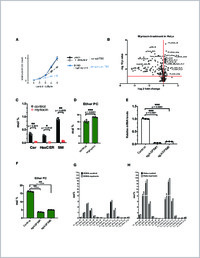Conserved functions of ether lipids and sphingolipids in the early secretory pathway
- Jiménez-Rojo, Noemi NCCR Chemical Biology, Department of Biochemistry, University of Geneva, 1211 Geneva, Switzerland -
- Leonetti, Manuel D. Department of Cellular and Molecular Pharmacology, University of California, San Francisco, San Francisco, CA 94158, USA - Howard Hughes Medical Institute, San Francisco, CA 94158, USA -
- Zoni, Valeria Department of Biology, University of Fribourg, Fribourg, Switzerland
- Colom, Adai NCCR Chemical Biology, Department of Biochemistry, University of Geneva, 1211 Geneva, Switzerland
- Feng, Suihan NCCR Chemical Biology, Department of Biochemistry, University of Geneva, 1211 Geneva, Switzerland
- Iyengar, Namrata R. Institute of Protein Biochemistry (IBP), Italian National Research Council (CNR), Napoli, Italy
- Matile, Stefan NCCR Chemical Biology, Department of Organic Chemistry, University of Geneva, 1211 Geneva, Switzerlan
- Roux, Aurélien NCCR Chemical Biology, Department of Biochemistry, University of Geneva, 1211 Geneva, Switzerland
- Vanni, Stefano Department of Biology, University of Fribourg, Fribourg, Switzerland
- Weissman, Jonathan S. Department of Cellular and Molecular Pharmacology, University of California, San Francisco, San Francisco, CA 94158, USA - Howard Hughes Medical Institute, San Francisco, CA 94158, USA
- Riezman, Howard NCCR Chemical Biology, Department of Biochemistry, University of Geneva, 1211 Geneva, Switzerland -
-
05.10.2020
Published in:
- Current Biology. - 2020, vol. 30, no. 19, p. 3775-3787.e7
English
Sphingolipids play important roles in physiology and cell biology, but a systematic examination of their functions is lacking. We performed a genome-wide CRISPRi screen in sphingolipid-depleted human cells and identified hypersensitive mutants in genes of membrane trafficking and lipid biosynthesis, including ether lipid synthesis. Systematic lipidomic analysis showed a coordinate regulation of ether lipids with sphingolipids, suggesting an adaptation and functional compensation. Biophysical experiments on model membranes show common properties of these structurally diverse lipids that also share a known function as glycosylphosphatidylinositol (GPI) anchors in different kingdoms of life. Molecular dynamics simulations show a selective enrichment of ether phosphatidylcholine around p24 proteins, which are receptors for the export of GPI-anchored proteins and have been shown to bind a specific sphingomyelin species. Our results support a model of convergent evolution of proteins and lipids, based on their physico-chemical properties, to regulate GPI- anchored protein transport and maintain homeostasis in the early secretory pathway.
- Faculty
- Faculté des sciences et de médecine
- Department
- Département de Biologie
- Language
-
- English
- Classification
- Biological sciences
- License
- License undefined
- Identifiers
-
- RERO DOC 329731
- DOI 10.1016/j.cub.2020.07.059
- Persistent URL
- https://folia.unifr.ch/unifr/documents/309106
Other files
Statistics
Document views: 208
File downloads:
- van_cfe.pdf: 393
- van_cfe_sm1.pdf: 150
- curbio_16723_mmc5.str.str: 62
- curbio_16723_mmc4.txt: 41
- summary.txt: 37
- hyper_semsitivity_hits.txt: 53
- myriocin_phenotype.txt: 148
- growth_phenotype.txt: 242
- resistants_hits.txt: 42
- van_cfe_sm3.pdf: 64



